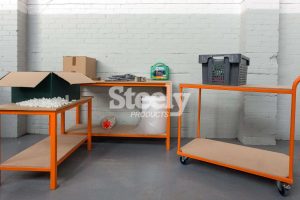Your basket is currently empty!

Serving as a centre for storing and sorting goods ready for despatch, warehouses play a critical role for many firms.
While a warehouse that runs smoothly is never a problem due to the integral part they play in supply chains, any issues left unresolved can lead to a range of unfavourable outcomes. Warehouse storage problems can have a significant impact on how enterprises operate and can lead to increased running costs, stock damage, delays, loss of profits and incorrect orders. Here, we study some of the most frequently encountered warehouse storage problems.
Space and layout
Inefficient space utilisation is a major risk for warehouses. Having the right type of racking that maximises the use of available space and suits the size, shape and weight of products stored is key.
Poor layout is also problematic. A well-designed warehouse ensures that all areas are easily accessible and that a clear flow exists between stock stored, order picking, packing and despatch areas for more streamlined operations.
Being unprepared for seasonal fluctuations can also cause havoc. If warehouses can’t scale their processes to answer increased seasonal demand, it can overwhelm staff and result in backorders.
Inventory and operations
Poor inventory management can cause overstocks, understocks, misplaced products and inaccurate counts, causing stockouts. Additionally, order fulfilment errors caused by poor picking and packing practices are another prevalent problem. Well-organised stock and racking, with trolleys that compartmentalise items, can reduce errors.
Not keeping accurate records of goods in and out results in a lack of traceability and affects reordering and stock availability. While some damage and loss are understandable, such issues can be mitigated using the strong shelving and material handling solutions that match products stored.
Labour and technology
Suboptimal labour management has a high cost. Having inexperienced or poorly trained workers can lead to inefficiencies and higher labour costs in the long run. Poor safety management can also lead to accidents and damaged goods, leading to health and safety fines and a loss in profit.
Using outdated or inadequate technology is also a problem. A lack of integration in storage facilities leads to significant problems like despatch delays and inventory inaccuracies. Today, technology is available to help storage hubs operate more efficiently, like warehouse management systems (WMS) that help avoid human errors and provide real-time data on stock.
Provided that you use a measured and well-considered approach to storage, practical racking systems and optimised layouts, avoiding these common pitfalls can be a simple process.
You may also interested in:

How businesses are making supply chains more sustainable
Major companies are investing more in green logistics that reduce the environmental footprint of
What is longspan shelving?
Using warehouse space wisely is a key consideration in various industries. What longspan shelving offers is
